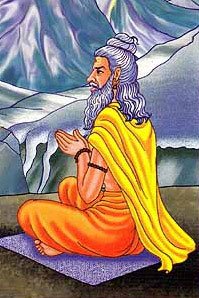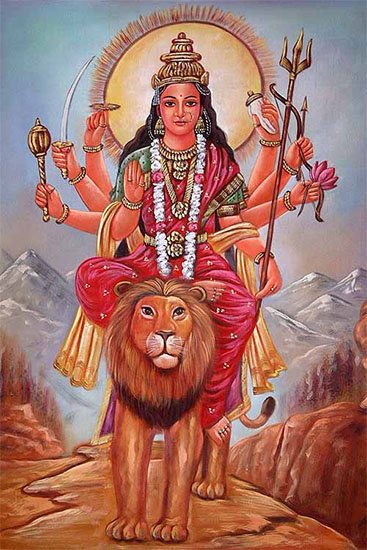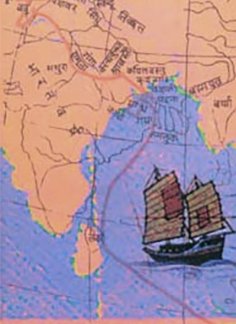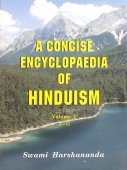Mahaprabhu, Mahāprabhu, Maha-prabhu: 11 definitions
Introduction:
Mahaprabhu means something in Hinduism, Sanskrit, the history of ancient India. If you want to know the exact meaning, history, etymology or English translation of this term then check out the descriptions on this page. Add your comment or reference to a book if you want to contribute to this summary article.
In Hinduism
Purana and Itihasa (epic history)
Source: archive.org: Shiva Purana - English Translation1) Mahāprabhu (महाप्रभु) refers to “one of great lordly status” and is used to describe Vajrāṅga, according to the Śivapurāṇa 2.3.14 (“The Birth of Tāraka and Vajrāṅga”).—Accordingly, after Vajrāṅga spoke to Brahmā: “[...] Thereafter the demon eschewed his diabolical feelings and resorted to sublime thoughts. Since he was free from fiendish feelings he became happy. But no sublime feeling entered in the heart of Varāṅgī. With chastity and faith she served her husband lovingly in diverse ways. Her husband Vajrāṅga of great lordly status [i.e., mahāprabhu] was glad very soon on account of her service. He then spoke thus:—[...]”.
2) Mahāprabhu (महाप्रभु) refers to “great lord” and is used to describe Brahmā, according to the Śivapurāṇa 2.3.15 (“The penance and reign of Tārakāsura”).—Accordingly, as Tāraka said to Brahmā: “O Pitāmaha, if you are glad and ready to grant me the boon what is it that cannot be achieved by me? Hence I request you for this boon. Please listen. O lord of gods, if you are pleased and if a boon is to be given to me, be kind enough to grant me two boons. O great lord [i.e., mahāprabhu], there should certainly be no man equal to me in strength in this entire universe created by you. [...]”.

The Purana (पुराण, purāṇas) refers to Sanskrit literature preserving ancient India’s vast cultural history, including historical legends, religious ceremonies, various arts and sciences. The eighteen mahapuranas total over 400,000 shlokas (metrical couplets) and date to at least several centuries BCE.
Shaktism (Shakta philosophy)
Source: Google Books: ManthanabhairavatantramMahāprabhu (महाप्रभु) refers to the “Great Lord” and is used to describe Bhairava, according to the Manthānabhairavatantra, a vast sprawling work that belongs to a corpus of Tantric texts concerned with the worship of the goddess Kubjikā.—Accordingly, “Bhairava, the Lord of the gods, the Great Lord (mahāprabhu), has been described (to you). He is the fearsome lord of the Tantras of the Left. Black, (his) consort accompanies him. O Śambhu, this is the Southern Tradition explained in (this) compendium of the Tantras. He is the preferred authority in the south and is adorned with Śikhārāja. Devoid of Kula and established by the method prescribed by the Lion Transmission, it has authority in the Dvāpara Age and is part of the Śrīkrama. Such is the Southern House, which bestows (much) fruit, recommended to you”.

Shakta (शाक्त, śākta) or Shaktism (śāktism) represents a tradition of Hinduism where the Goddess (Devi) is revered and worshipped. Shakta literature includes a range of scriptures, including various Agamas and Tantras, although its roots may be traced back to the Vedas.
India history and geography
Source: Cologne Digital Sanskrit Dictionaries: Indian Epigraphical GlossaryMahāprabhu.—(EI 21, 32), sometimes used in respect of subordinate rulers; (HD), a governor; cf. Ep. Ind., Vol. XII, p. 335. (SITI) ‘the great banker’; the senior merchant; the title by which the leader of the nānāde3si merchant community was designated. (IA 30), a village official; see Prabhu. (EI 19), explained as ‘the high sheriff’. Note: mahāprabhu is defined in the “Indian epigraphical glossary” as it can be found on ancient inscriptions commonly written in Sanskrit, Prakrit or Dravidian languages.

The history of India traces the identification of countries, villages, towns and other regions of India, as well as mythology, zoology, royal dynasties, rulers, tribes, local festivities and traditions and regional languages. Ancient India enjoyed religious freedom and encourages the path of Dharma, a concept common to Buddhism, Hinduism, and Jainism.
Languages of India and abroad
Sanskrit dictionary
Source: DDSA: The practical Sanskrit-English dictionaryMahāprabhu (महाप्रभु).—
1) a great lord.
2) a king, sovereign.
3) a chief.
4) an epithet of Indra.
5) of Śiva
6) of Viṣṇu.
7) a great saint or holy man.
Derivable forms: mahāprabhuḥ (महाप्रभुः).
Mahāprabhu is a Sanskrit compound consisting of the terms mahā and prabhu (प्रभु).
Source: Cologne Digital Sanskrit Dictionaries: Shabda-Sagara Sanskrit-English DictionaryMahāprabhu (महाप्रभु).—m.
(-bhuḥ) 1. A holy man, a saint. 2. A king. 3. Indra. 4. Siva. E. mahā chief, and prabhu master.
Source: Cologne Digital Sanskrit Dictionaries: Cappeller Sanskrit-English DictionaryMahāprabhu (महाप्रभु).—[masculine] great lord or king.
Source: Cologne Digital Sanskrit Dictionaries: Monier-Williams Sanskrit-English Dictionary1) Mahāprabhu (महाप्रभु):—[=mahā-prabhu] [from mahā > mah] m. a gr° master, mighty lord, king, prince (-tva n.), [Upaniṣad]
2) [v.s. ...] a very holy man or gr° saint, [Horace H. Wilson]
3) [v.s. ...] a chief, [Horace H. Wilson]
4) [v.s. ...] Name of Indra, [cf. Lexicographers, esp. such as amarasiṃha, halāyudha, hemacandra, etc.]
5) [v.s. ...] of Śiva, [cf. Lexicographers, esp. such as amarasiṃha, halāyudha, hemacandra, etc.]
6) [v.s. ...] of Viṣṇu, [cf. Lexicographers, esp. such as amarasiṃha, halāyudha, hemacandra, etc.]
Source: Cologne Digital Sanskrit Dictionaries: Yates Sanskrit-English DictionaryMahāprabhu (महाप्रभु):—[mahā-prabhu] (bhuḥ) 2. m. A sage, a holy man; a king; Indra; Shiva.
[Sanskrit to German]
Sanskrit, also spelled संस्कृतम् (saṃskṛtam), is an ancient language of India commonly seen as the grandmother of the Indo-European language family (even English!). Closely allied with Prakrit and Pali, Sanskrit is more exhaustive in both grammar and terms and has the most extensive collection of literature in the world, greatly surpassing its sister-languages Greek and Latin.
Kannada-English dictionary
Source: Alar: Kannada-English corpusMahāprabhu (ಮಹಾಪ್ರಭು):—
1) [noun] a great leader, master.
2) [noun] a king.
3) [noun] a chief officer.
4) [noun] Śiva.
5) [noun] Viṣṇu.
6) [noun] Indra, the lord of gods.
7) [noun] a sage of great merit.
8) [noun] a term of addressing men of dignity, high office, etc.
Kannada is a Dravidian language (as opposed to the Indo-European language family) mainly spoken in the southwestern region of India.
See also (Relevant definitions)
Partial matches: Maha, Prabhu.
Starts with: Mahaprabhutva.
Full-text (+155): Mahaprabhutva, Haribhaktivilasa, Nityanandarabhu, Caitanya, Pillai-mapirapu, Prabhu, Kamakoshthi, Vishrama-ghata, Shridharasvamipada, Mahavidya, Bhuteshvara, Svayambhu, Dirgha-vishnu, Shabdaguna, Laukikariti, Mridanga, Avesha, Smarta, Gaudiyavaishnava, Kurmakara.
Relevant text
Search found 22 books and stories containing Mahaprabhu, Mahāprabhu, Maha-prabhu, Mahā-prabhu; (plurals include: Mahaprabhus, Mahāprabhus, prabhus). You can also click to the full overview containing English textual excerpts. Below are direct links for the most relevant articles:
Garga Samhita (English) (by Danavir Goswami)
Verse 5.14.32 < [Chapter 14 - The Meeting of King Nanda and Uddhava]
Chaitanya Bhagavata (by Bhumipati Dāsa)
Introduction to chapter 4 < [Chapter 4 - Descriptions of Śrī Acyutānanda’s Pastimes and the Worship of Śrī Mādhavendra]
Introduction to chapter 6 < [Chapter 6 - The Lord’s Meeting with Advaita Ācārya]
Introduction to chapter 13 < [Chapter 13 - The Deliverance of Jagāi and Mādhāi]
Śrī Kṛṣṇa-vijaya (by Śrī Gunaraja Khan)
My Fair Lady is Indian < [April 1971]
Let the Stream of Compassion flow < [July – September 1975]
The Spirit of Tolerance < [April - June 1976]
Brihad Bhagavatamrita (commentary) (by Śrī Śrīmad Bhaktivedānta Nārāyana Gosvāmī Mahārāja)
Verse 1.4.72 < [Chapter 4 - Bhakta (the devotee)]
Verse 1.4.107 < [Chapter 4 - Bhakta (the devotee)]
Jainism in Odisha (Orissa) (by Ashis Ranjan Sahoo)
Jagannatha Temple, Baripada < [Chapter 3: Survey of Jaina Antiquities in Odisha]
Related products
